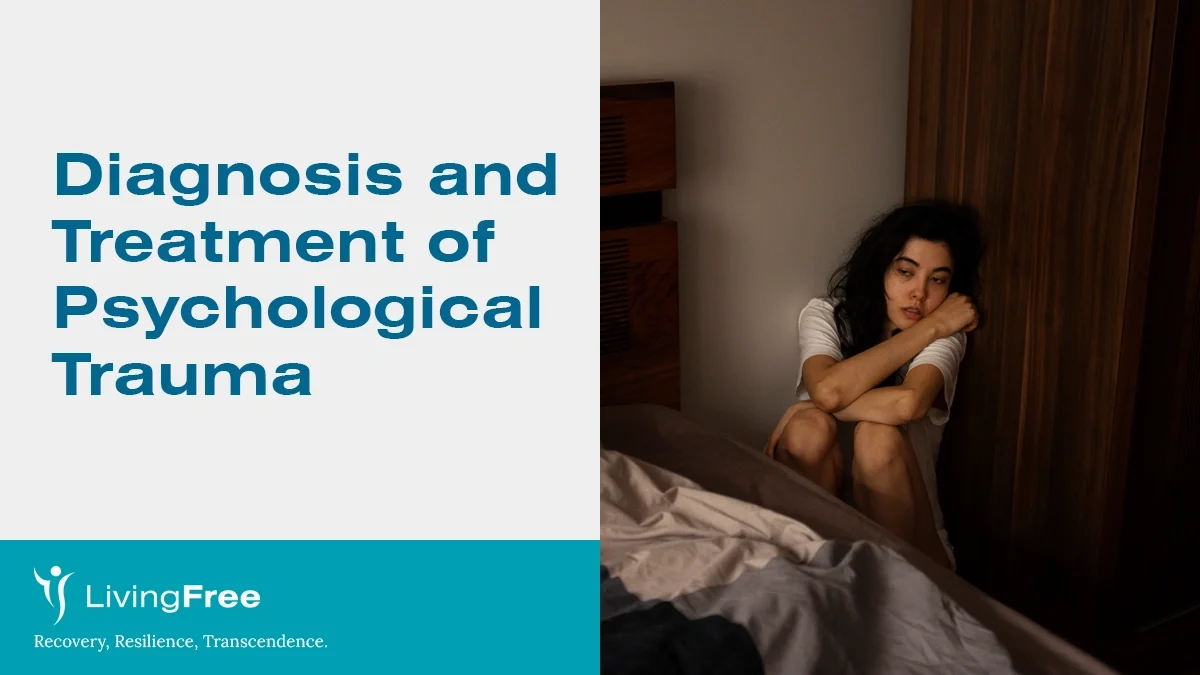Psychological trauma is a serious mental health condition resulting from experiencing or witnessing distressing or life-threatening events. Trauma overwhelms an individual’s ability to cope, leading to lasting emotional, cognitive, and physiological consequences.
When left untreated, trauma can evolve into mental disorders such as post-traumatic stress disorder (PTSD), acute stress disorder (ASD), depression, substance use disorders, or complex PTSD (cPTSD). Fortunately, accurate diagnosis and evidence-based treatment approaches offer effective paths to recovery.
How Psychological Trauma Is Diagnosed
There is no blood test or imaging scan that can confirm psychological trauma. Diagnosis is clinical and relies on thorough assessment by mental health professionals using standardized criteria and validated tools.
Diagnostic Criteria (DSM-5-TR)
The Diagnostic and Statistical Manual of Mental Disorders, Fifth Edition, Text Revision (DSM-5-TR) categorizes PTSD under Trauma- and Stressor-Related Disorders. To meet diagnostic criteria for PTSD, an individual must have experienced trauma (directly or indirectly) and present symptoms from four core clusters for over one month, with significant distress or functional impairment:
- Intrusion symptoms: Unwanted memories, nightmares, or flashbacks.
- Avoidance: Avoidance of trauma-related thoughts, people, or situations.
- Negative alterations in cognition and mood: Persistent negative beliefs, emotional numbness, guilt, or detachment.
- Arousal and reactivity: Hypervigilance, sleep disturbances, irritability, or concentration problems.
Unlike the DSM-IV, the DSM-5 and DSM-5-TR no longer require the person to report a subjective reaction of intense fear, helplessness, or horror during the traumatic event for diagnosis (Criterion A2 removed).
Validated Screening Tools
To support diagnosis and treatment monitoring, clinicians often use:
- PCL-5 (PTSD Checklist for DSM-5)
- CAPS-5 (Clinician-Administered PTSD Scale)
- IES-R (Impact of Event Scale – Revised)
- SCID-5 (Structured Clinical Interview for DSM Disorders)
These tools measure symptom severity and track treatment progress.
Recognized Trauma-Related Disorders
Acute Stress Disorder (ASD)
Symptoms begin within three days to one month after the trauma. Dissociation, intrusive thoughts, and emotional distress are common. ASD can resolve naturally, but about 50% of cases transition into PTSD if symptoms persist.
Post-Traumatic Stress Disorder (PTSD)
PTSD symptoms last longer than one month and impair social, occupational, or emotional functioning. Common triggers include combat, assault, disasters, abuse, and serious medical events like intensive care or childbirth.
Complex PTSD (cPTSD)
Recognized in the ICD-11 (but not yet in DSM-5-TR), cPTSD stems from prolonged or repeated trauma, often in childhood. Alongside standard PTSD symptoms, it includes:
- Emotional dysregulation
- Negative self-image (e.g., shame, guilt)
- Chronic relational difficulties
Adjustment Disorder
Triggered by life stressors (e.g., divorce, job loss), adjustment disorder involves excessive distress and functional disruption. Symptoms usually resolve within six months with support.
Treatment Options for Psychological Trauma
Psychotherapy: The First-Line Treatment
Psychological therapy is the cornerstone of trauma treatment. Evidence-based modalities include:
- Trauma-Focused Cognitive Behavioral Therapy (TF-CBT): Combines cognitive restructuring and behavioral techniques to reframe trauma-related thoughts and improve coping.
- Prolonged Exposure (PE): Gradual, controlled exposure to trauma cues reduces avoidance and fear.
- Cognitive Processing Therapy (CPT): Targets distorted beliefs (e.g., self-blame, helplessness) and helps reprocess trauma narratives.
- Eye Movement Desensitization and Reprocessing (EMDR): Uses guided eye movements while recalling trauma memories to facilitate safe emotional processing
These therapies are typically delivered by trauma-trained clinicians in individual or group settings.
Medications
Medication can be helpful for managing symptoms like anxiety, insomnia, and depression, especially in combination with psychotherapy.
- SSRIs: Sertraline (Zoloft) and paroxetine (Paxil) are FDA-approved for PTSD. They help improve mood and reduce anxiety.
- Prazosin: May reduce nightmares and improve sleep in PTSD, though findings are mixed.
- Anti-Anxiety Medications: Benzodiazepines may be used briefly for acute symptoms but are not recommended long-term due to dependency risk.
Innovative and Emerging Treatments
Stellate Ganglion Block (SGB)
SGB involves injecting a local anesthetic into the stellate ganglion to calm overactivity in the sympathetic nervous system. Studies show significant reductions in PTSD symptoms, particularly for hyperarousal and intrusive thoughts.
Left-sided SGB has shown benefits for individuals unresponsive to right-sided treatment. While promising, SGB remains experimental and is typically used as an adjunct to therapy.
Supportive Strategies and Self-Care
Healing from trauma involves more than therapy or medication. Recovery is also supported by:
- Re-establishing daily routines
- Prioritizing sleep, nutrition, and physical activity
- Practicing grounding exercises (e.g., mindfulness, deep breathing)
- Avoiding alcohol and illicit substances
- Seeking safe emotional support from friends or support groups
- Engaging in creative outlets (writing, art, music)
- Learning about trauma responses to reduce shame and self-blame
When to Seek Help
It’s important to consult a mental health professional if you or someone you know:
- Experiences trauma symptoms for more than a few weeks
- Avoids reminders of the trauma
- Has frequent nightmares, flashbacks, or panic attacks
- Feels emotionally numb or disconnected
- Uses substances to cope
- Has suicidal thoughts or self-harming behaviors
Outlook and Long-Term Recovery
Recovery is possible. According to the World Health Organization, up to 40% of people with PTSD recover within one year. With access to therapy, medication, and social support, most individuals show significant improvement over time.


